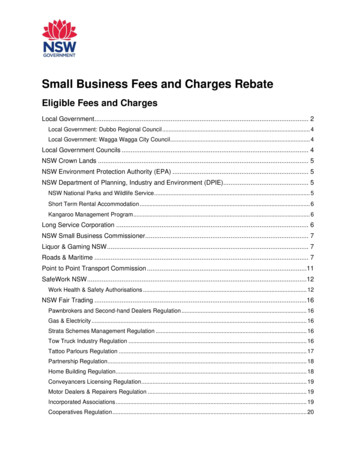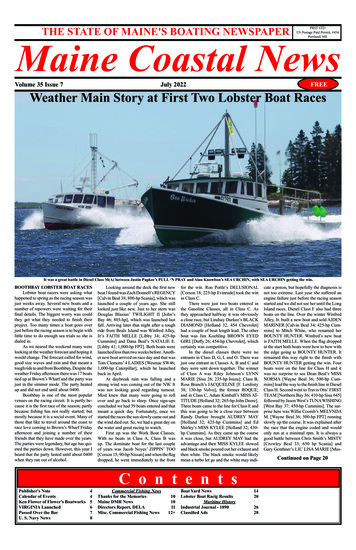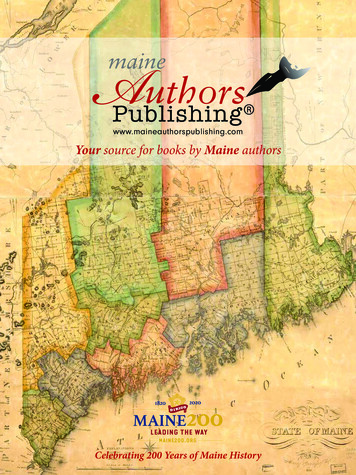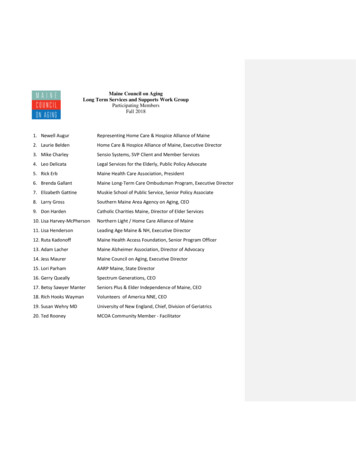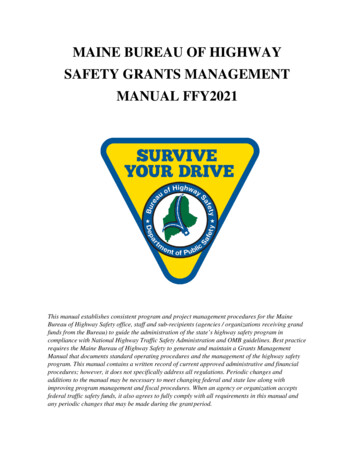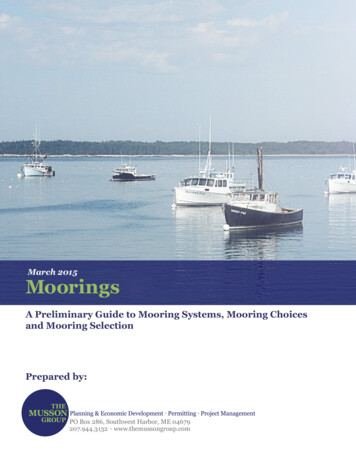
Transcription
March 2015MooringsA Preliminary Guide to Mooring Systems, Mooring Choicesand Mooring SelectionPrepared by:PO Box 286, Southwest Harbor, ME 04679207.944.3132 www.themussongroup.com
Consideration for MooringsA Preliminary Guide to Mooring Systems,Mooring Choices and Mooring SelectionPrepared For:Maine Coastal ProgramDepartment of Agriculture, Conservation & Forestry93 State House StationAugusta, Maine 04333For More Information, Contact:Noel MussonThe Musson Group207-244-1161noel@themussongroup.comMatthew Nixon, Assistant DirectorMaine Coastal ProgramMaine Department of Agriculture,Conservation and Forestry207-287-1491matthew.e.nixon@maine.govRuta Dzenis AICP, Senior PlannerMunicipal Planning Assistance ProgramMaine Department of Agriculture,Conservation and Forestry207-287-2851ruta.dzenis@maine.govThis report was prepared by The Musson Group under award CZM NA13NOS4190045 to the MaineCoastal Program from the National Oceanic and Atmospheric Administration, U.S. Departmentof Commerce. The statements, findings, conclusions, and recommendations are those of theauthor(s) and do not necessarily reflect the views of the National Oceanic and AtmosphericAdministration or the Department of Commerce.
Table of ContentsIntroduction and PurposeOverview of a Mooring SystemMooring System LayoutMooring Planning ConsiderationsConservation MooringsConsideration for Harbor CommitteesSources ConsultedAcknowledgementsThis report was prepared with assistance of several knowledgeable individuals. Theauthor would like to thank the members of the Maine Harbor Masters Association Board ofDirectors for their suggestions, input and guidance. Specifically Katherine Pickering, DaveSchmanska, Jim Hayes, Chris Mayo, Jay Pinkham, Charlie Phippen, Dave Corbeau, ShawnHebert, and Ed Glaser. We would like to thank Wayne Hamilton, Owner of Hamilton Marineand Searsport Harbormaster for his previous research and training on moorings. We wouldalso like to thank Josh Willard from Chalmers Enterprises, Jay Clement from the Army Corpsof Engineers, Matthew Nixon from the Maine Coastal Program, and Ruta Dzenis from theMunicipal Planning Assistance Program for their contributions to this document.
Introduction and PurposeFOR MOST BOATERS, SHORESIDE DOCKAGE IS NOT POSSIBLE OR PRACTICAL. Therefore,most use some type of mooring. While much can be written about moorings, the focus of this reportis to provide an overview tool that can be referred to when considering alternative mooringsoptions. While specifications on equipment are not addressed in this report, the reader, whether aHarbor Master, local committee member, or interested citizen, can refer to this report as a preliminaryguide when considering a mooring for their individual boat, as part of an overall harbor planningeffort, or when considering new ways to protect sensitive harbor resources such as eelgrass, shell fishbeds, and lobster habitat. There are many design considerations when establishing a reliable mooringsystem. One must consider the depth of water (in Maine, tides commonly range 12 feet or more), sizeof the vessel, the exposure of the location, current, the type of bottom, the swinging room available,the chain and pennant size needed, and the vessel hardware layout. This report will touch on manyof those considerations. However, as Wayne Hamilton, Harbor Master for the Town of Searsport andowner of Hamilton Marine, said in his training packet to the Maine Harbor Masters Association, “Themost reliable mooring systems are those tested by time and gradually improved with technology.” Inaddition, all harbors have unique characteristics which must be considered and many communitieshave specific requirements set out in Harbor Ordinances. Therefore, it is extremely important to consultwith local experts such as Harbor Masters and marine professionals who regularly install moorings.Consideration for Moorings: A Preliminary Guide to MooringSystems, Mooring Choices and Mooring Selection1
Overview of a Mooring SystemA MOORING REFERS TO ANY PERMANENT STRUCTURE to which a vessel may be secured.A “mooring system” refers to the various components – an anchor, a rode (typically a rope, chain, orcable), a buoy, and a pennant.THE ANCHORAn anchor is used to fix a vessel to a point on the bottom of the seafloor without connecting it to land.There are four basic types of anchors used in moorings:Deadweight Anchors. Deadweight anchors are the simplest type of anchor and, in many harbor settings,provide the greatest reliability. Their holding power is through weight. Once the heavy weight settleson the bottom, the anchor becomes embedded and the suction effect helps to increase its holdingpower. Deadweight anchors can be made of most any heavy object but are typically a large stoneblock or concrete. Due to theirsize and weight, these anchorstypically require a barge to set.Mushroom Anchors. Mushroomanchors get their name fromtheir shape, which looks like anupside down mushroom. Theywork best in mud, sand, silt orother soft ocean bottoms wherethey can be easily buried. Onceburied, a mushroom mooring istypically thought to be able tohold up to 10 times its weight.Top: Deadweight Anchors; Bottom: Mushroom AnchorsIn certain conditions, mushroomanchors that are not properly embedded in the bottom can dislodge and lose holding power. This iscommonly referred to as “spin out.” Additionally, mushroom anchors run the risk of having the chainwrap around the shaft of the anchor when not properly set. This can reduce the scope of the mooring.Pyramid Anchors. As the name implies, these one piece cast iron anchors are shaped like a pyramid.Pyramid anchors are essentially a redesigned version of a mushroom anchor. They are comparablein terms of holding strength, but their smaller size pyramid shape helps them penetrate the bottommore rapidly. Pyramid anchors have a shorter anchor shaft which helps to minimize the potential forchain wrap and also makes then useful in more shallow water settings. These anchors are used inhard, rocky or sandy bottoms. Sometimes these anchors are call “Dor-Mor” anchors after one of theirmanufacturers.Helix Anchors. Helix (or screw-in) anchors are made of high tensile steel with an attachment eyeat the top and large threads at the lower end. These anchors come in long (8 ft.) lengths withConsideration for Moorings: A Preliminary Guide to MooringSystems, Mooring Choices and Mooring Selection2
varying diameters of threads (10”,14”). To set the anchor, they arescrewed in until the top eye isessentially flush with the bottomconnected to traditional groundtackle. While screw-in or helixanchors have been used by theoffshore oil industry for well over20 years, they are a relatively newtechnology in anchoring systemsfor the yachting and smallercommercial vessel markets.Recent industry tests are showingthat these anchors can offerTop: Pyramid Anchors; Bottom: Helix Anchorssignificantly more holding powerthat traditional anchors when set property and in the right conditions. These anchors may also helpeliminate or minimize damage to sensitive benthic resources like eel grass, shellfish beds and lobsterhabitat. (See discussion on conservation moorings)Consideration for Moorings: A Preliminary Guide to MooringSystems, Mooring Choices and Mooring Selection3
TABLE 1. ANCHOR SUMMARY idMushroomDeadweightPOWERAn 8,000lb.concretemooring hasapproximately4,000lb. ofholding power Simple design Good for mostbottom types Still holdsposition evenif draggedduring storm Heavy, bulky,requiresassistance forinstallation Better suited for rock bottoms than otheranchors Deadweight moorings made from concretecan lose over half their weight whensubmerged in water Deadweight moorings made from granitecan lose over a third of their weight whensubmerged in water Fault lines in stone anchors can crack whenputting in staplesA 500lb.mushroomanchor hasapproximately1,200lb. ofholding power Has a highholding powerto-weight ratio Limitedsuccess inrocky areas Prone to spinout and chainwrap A 650lb. pyramidanchor hasapproximately6,500lb. ofholding power Has high holding power toweight ratio Simple design Limitedsucceess inrocky areas Higher cost Better suited for muddy bottom conditions Size and shape help it penetrate the bottommore rapidly Generally, weight of pyramid anchors wouldbe 10-20 lbs per foot of boat in mud bottomA 10” screwHelix anchor hasapproximately10,000lb. ofholding power High holding power toweigh ratio Small size Longevity More environmentallysensitive Specializedinstallerneeded Difficult inrock Heavy, bulky,requiresassistance forinstallation More difficultto move Better suited for softer bottom conditionsand don’t perform as well in rocky bottomconditions Type of helix used might differ with conditionof bottom. Requires diver to set and maintainBetter suited for muddy bottom conditionsLimited success in rocky areasProne to spin out and chain wrapBetter suited for muddy bottom conditionsGenerally, weight of mushroom anchorswould be 10-20 lbs per foot of boat in mudbottom Proper installation is important to assure it isburiedTHE RODE SYSTEMThe Rode system, which runs from the anchor to the mooring buoy, has two basic parts – a groundline and a riding line. The ground line, which lies on the bottom, is traditionally made up of heavychain (bottom chain). The riding line is typically a smaller sized chain called “top chain.” The rode canalso be made of line or cable.The rode system is normally several times longer than the depth of the water (typically 1 1/2 timesmaximum water depth but varies depending on harbor conditions) to assist in the angle of forces thatare placed on an anchor. The longer the rode, the lower the angle of force will be on the anchor. Asmore of the force is pulled horizontally, the holding power of a traditional anchor improves. A longerrode also increases the swinging circle (scope) of each mooring. By adding weight to the bottom ofConsideration for Moorings: A Preliminary Guide to MooringSystems, Mooring Choices and Mooring Selection4
the rode, such as using a length of heavy bottom chain, the angle of force can be decreased further.Heavy bottom chain can scrape the harbor bottom around the anchor. Newer technologies havebeen designed to help alleviate this. (See discussion onConservation Moorings in the next section.)Shackles and swivels are used to connect the anchor,bottom chain, top chain and mooring buoy together.Shackles and swivels can become weak links in themooring system. Therefore high quality parts are animportant consideration.THE MOORING BUOYThe mooring buoy has two functions. First, it serves tosupport the rode and floats it off the bottom. Second,it absorbs the shock of heavy waves and wind whichhelps to increase holding power. US Coast Guard andmany Harbor Ordinances have regulations aroundthe type and color of mooring buoys. Many buoysare constructed of polyethylene plastic filled withpolyurethane foam and treated with UV inhibitors.However, air inflated net buoys are also commonly useddue to their lower costs.Top: Illustration showing mooring rode; Bottom: Typical buoyPENNANTSThe pennant ties the boat to the mooring. The pennant should run as straight as possible to avoidchaffing. The sharper the angle of the pennant the greater pressure on the line which increases chaffing.Some harbors ordinances require a secondary or “safety” pennant which is typically longer than theprimary pennant and used as a back-up in case the primary fails.Consideration for Moorings: A Preliminary Guide to MooringSystems, Mooring Choices and Mooring Selection5
Mooring System LayoutSWING MOORINGSSwing moorings, also known as “single-point” moorings, are the simplest and most common kind ofmooring. For these types of moorings systems a boat is attached to a single anchor and swings aboutin a circle around that anchor. The boats swing can vary depending on the length of the boat and depthof water. In many harbors, the swing moorings are sited so that the scope or “circle of influence” of eachboat does not overlap. In some harbors it might be possible to increase the number of moorings bysiting them so that the swing circles overlap. This is very effective in areas where boats of similar size andcharacter are moored. In mixed harbors it becomes more difficult since a 30 foot lobster boat will behavedifferently than a 30 foot sail boat.MULTIPLE ANCHOR MOORINGSThere are several options for multiple anchoring moorings. A double mooring system uses a pair ofanchors with an additional rode between the two primary rodes. The anchors can be set fore and aftto fix a vessels position more precisely or spaced apart at twice the water depth to reduce the scopeof a traditional single point mooring. In some situations a third anchor can be added.PILE MOORINGSPile moorings use a wooden or steel pile driven into the sea bottom to act as the anchor. These mooringsare not typically used but can be effective in some harbor setting. Multiple piles can be used to fix theboats position.MOORING FLOATSThese are actually narrow floating docks which are long enough for boats to tie up to each side of thefloat. Because each boat and the float rides on the mooring, the mooring must have a strong enoughanchor. In many harbors this means that two or more anchors are required. The users of the float aresometimes the owners of the float. In other situations, the owner is the municipality and the floats areleased to the boat owners. Moorings floats work well in more sheltered harbors.Consideration for Moorings: A Preliminary Guide to MooringSystems, Mooring Choices and Mooring Selection6
Mooring Planning ConsiderationsHABITATMany harbors and mooring areas are home to eel grass beds and other significant habitat resourcesthat are important to our marine environment and coastal economies. Eel grass, for example, playsan important role in providing spawning and nursery ground as well as serving as foraging grounds,areas of refuge, and food sources. In areas where these sensitive habitats exist, communities shouldconsider the effectiveness of Conservation Moorings to help minimize the impacts moorings can have.The Maine Department of Marine Resources has an eel grass inventory for current/historic extent ofeel grass along Maine’s coast. This information can be accessed at http://www.maine.gov/dmr/maps/mapindex.html.HARBOR BOTTOMThe type of harbor bottom (rocky, muddy, sandy, etc.) is an important consideration for what type ofanchor is used. As noted above, some anchors are well suited for soft muddy bottoms, but will notfunction as needed in hard rock bottoms.EXPOSUREExposure to open sea and fetch, which is the distance traveled by wind or waves across open water,allows wave and wind strength to build enough force to drag gear around. Therefore more exposedareas require heavier gear while more sheltered location requires less hefty ground tackle.HOLDING CAPACITYThere are many variables in determining appropriate holding capacity - the wind, depth of water, bottomconditions, currents, and seas, all have influences. Holding capacity of a mooring depends on factorssuch as the strength of the rodes, the deck hardware, the shackles, and the resistance of the anchor.Additionally, the size and type of vessel make a big difference. A sailing vessel is more streamline, wherepower vessels are usually wider. Even if both vessels were the same weight, the power vessel mightstress the mooring a lot more on a windy day. Swells and storm surges can cause water levels to risewhich will have an effect on the holding capacity the anchor. Anchors are designed to hold best whenpulled on at an angle. On a traditional mooring, as water rises, the boat is pulled toward the anchor.If the scope is too short, or if water levels rise enough, the boat may end up directly over the anchor.This would cause the boat to pull up on the anchor which would compromise its holding capacity.MAINTENANCEThe holding capacity and effectiveness of any mooring system is directly related to the maintenanceof its various components. Buying quality chain and hardware is an important aspect of a functionalmooring system. Most harbor regulations have specific timeframes for inspections and replacement.Moorings of any type should be maintained at least annually to ensure safety. In many harbors, the issueof electrolysis eroding mooring hardware is becoming more of a concern. In these areas mooring systemsshould be inspected more often.Consideration for Moorings: A Preliminary Guide to MooringSystems, Mooring Choices and Mooring Selection7
ECONOMIC CONSIDERATIONSThe cost of a mooring involves several factors including installation costs (which could range from 200.00for a simple installation to 500.00 or more depending on location), equipment costs, maintenance,insurance, and mooring fees. These costs can vary depending on the complexity of the installation,location of the mooring, and bottom conditions. Helix anchors can be more expensive to install due tothe specialized installation requirements.The information below is provided as a means of comparing costs. Actual prices should be verified. 400 lb. mushroom anchor: Ranges from approximately 500.00 to 800.003,000 lb. concrete block anchor: Ranges from approximately 400.00 to 700.00Helix anchor: Ranges from approximately 400.00 to 700.005/8” chain: Approximately 9.50/foot 134.85 for 15’3/4” chain: Approximately 16.00/foot 467.70 for 30’REGULATORY CONSIDERATIONMoorings are regulated by Federal, State and Local rules.Army Corp of Engineers (ACOE). Performing work in coastal waters, including placing moorings, is regulatedby the ACOE under the Rivers and Harbors Act of 1899 (33 U.S.C 401, 403, 407). Section 10 (33 U.S.C. 403)prohibits “ the creation of any obstruction not affirmatively authorized by Congress, to the navigablecapacity of any of the waters of the United States.” Permits are also required under Section 404 of theClean Water Act for the discharge of dredge or fill material into all waters – tidal and freshwater – andtheir adjacent wetlands. For more information from the Army Corps visit their website at http://www.nae.usace.army.mil/.State of Maine. The State plays an important role in many coastal projects including moorings, floats,piers and wharfs. State agencies to consult include the Maine Department of Environmental Protectionand the Department of Agriculture, Conservation and Forestry’s Bureau of Submerged Lands. For moreinformation from the Maine Department of Environmental projection visit their website at http://www.maine.gov/dep/land/index.html. Additional information from the Department of Agriculture,Conservation and Forestry Bureau of Submerged Lands can be found at http://www.maine.gov/dacf/parks/about/submerged lands.shtml.Municipalities. The State of Maine has the right to confer authority over some coastal regulations directly tomunicipalities. This includes the power to issue temporary and annual permits to the public for mooring ofvessels and related structures under such terms, conditions and restrictions as the municipality may deemnecessary. Local municipalities should have outlined these rules in their Harbor or Coastal Ordinances.Consideration for Moorings: A Preliminary Guide to MooringSystems, Mooring Choices and Mooring Selection8
Conservation MooringsA CONSERVATION MOORING IS SIMPLY A MOORING SYSTEM that is designed to minimizeimpacts to habitat. This can be achieved by reducing the contact between the bottom chain andthe ocean bottom, by minimizing the potential for the bottom chain to scour the seafloor around themooring anchor, or by providing added habitat throughthe anchor system itself.THE ANCHORAppropriate anchoring is largely determined by thebottom condition (mud, rock, cobble, etc.). Mostconservation mooring systems work well with any typeof anchor. The helix anchor is typically preferred due toits minimal footprint. Newer deadweight anchors suchas the Habitat Mooring have been designed to providehomes for marine organisms.THE RODEThe main component of any conservation mooringis to keep the bottom chain off the sea floor. In someapplications a float is used to keep the heavy bottomchain from making contact with the bottom. In mostapplications, an elastic/floating rode system is used. Forthese systems, the flexibility of the rode replaces thebuffering function of a traditional heavy bottom chainand the rode is able to float off the bottom. An extraline is often used to reinforce the lines and safeguardagainst overstretching and breakage.Conservation style rodes also have added benefitsduring storm events. While the lines used on aconventional moorings has some stretch, conservation Top: Aerial view showing mooring chain effect on eelgrass bed;rodes are specifically designed to stretch, generating Middle: Habitat mooring; Bottom: Diver looking at damage toeelgrass bed from mooringmore horizontal holding force earlier in the boatsmovement.One concern is that the elastic component of the rode that floats near the surface could becometangled in boating activities. Therefore it is important to make sure they are submerged beyond thereach of boat propellers.Consideration for Moorings: A Preliminary Guide to MooringSystems, Mooring Choices and Mooring Selection9
COMMON MANUFACTURERSA recent study by the Urban Harbors Institute indicated that there are three (3) common conservationmooring systems used in New England. They are: the Eco-Mooring System made by boatmoorings.com,the Hazelett Elastic Mooring System made by Hazelett Marine, and the Stormsoft Elastic Boat MooringSystem. These systems seem to be primarity used in Massachusetts including Salem, Provincetown,Gloucester, Nantucket and Chatham.Some harbors in Maine have startedto explore the use of conservationmooring components. Wells Harbor,for example, has begun to install alimited number of helix anchors. TheTown of Mount Desert has installed aHabitat Mooring as a test mooring inSeal Harbor. According to the UrbanHarbors Institute, several Harbors inLeft: Illustration of Eco-Mooring; Middle: Illustration of Hazelett Elastic MooringMassachusetts .System; Right; Illustration of Stormsoft Elastic Boat Mooring SystemTABLE 2. COMMON CONSERVATION MOORING oftSystemANCHORBUOYRODEUses variousanchortypes (helixrecommended)Uses any buoyPoly fiber rope surrounds a stretchableelastic rubber component. Thesurrounding rope stretches to providestrength (similar to a Chinese fingertrap).Helical anchoror deadweight(specificallya concrete orgranite block)Company has developeda spar buoy that can slipbelow the ice during thewinter. It is a standard partof the mooring systemA polymer elastic rode (or series ofrodes). The rode system is held off thebottom with trawl floats.Uses various anchor types, helixrecommendedUses any buoyA “downline” consisting of rubbermulti-strand cords surrounded by abraided polyester shell/rope. An innercore maintains the position of theshock absorbing rubber.Source: Urban Harbors Institute, Conservation Mooring Study, 2013Consideration for Moorings: A Preliminary Guide to MooringSystems, Mooring Choices and Mooring Selection10
Considerations for Harbor CommitteesMOORINGS IN THE OFF SEASONWhen reviewing the harbor ordinance municipalities may want to consider adding rules onappropriateoff season storage. In harbors where the moorings stay in place, this couldinclude language on sinkingmoorings just under the water line or in some cases simplyremoving the mooring.PLANNING FOR OUTER HARBOR AREASAccording to several harbor masters, the demand for mooring space is increasing. In manyharbors thishas led to lengthy wait lists in the tradition harbors (or inner harbor) due tolimited space. Often, manycommunities begin to look toward outer harbor areas foradditional mooring space. These areasare often more exposed and require additionalthought with regard to mooring system requirements.SHORE SIDE ACCESS CAN BE A LIMITING FACTOR FOR ADDING MOORINGSIn several harbors, it is not the space in the harbor itself that is limiting the ability to issue new moorings.Instead it is the shoreside access facilities. Several municipal docks are small, have informal parkinglayout, and have limited room for expansion within existing property boundaries. The result is parkingareas and dinghy tie-ups can get full.REFERENCE YOUR COMMUNIT Y’S COMPREHENSIVE PLAN OR STATE HABITATINFORMATIONWhen considering whether to expand an existing or develop a new mooring field location, considerwhether or not your municipality has goals or criterion for the geographic area in question. Additionally,it may be helpful to investigate the State’s habitat information (eelgrass/clamming flats, etc) in orderto mitigate environmental impacts to the seafloor.ENGAGE YOUR USERSThe Maine Coastal Program and the Maine Department of Transportation offer grant opportunities, notjust for engineering, design, and construction purposes, but for community engagement purposes.Work with your users to figure out what, if any, changes need to be made to your municipality’s existingmooring field, access, or amenities.Consideration for Moorings: A Preliminary Guide to MooringSystems, Mooring Choices and Mooring Selection11
Sources ConsultedAmerican Underwater Contractors websiteOnline at: http://www.ameriocanunderwatercontractors.comAnnes Anchors websiteOnline at http://www.annesanchors.com/seating.htmlEco Mooring Systems website.Online at mHabitat Mooring Systems websiteOnline at: http://www.habitatmooring.comHamilton Marine websiteOnline at http://www.hamiltonmarine.com/Hamiton, Wayne. Mooring Assembly. Presentation Materials from the Maine Harbor Masters AssociationAnnual Training Program. March 2013Hazelett Marine websiteOnline at: http://www.hazelettmarine.com/INAMAR, Recreational Marine Insurance Company. MooringsOnline at http://www.INAMARmarine.comJamestown Distributors websiteOnline at: http://www.jamestowndistributors.comLanier, Frank. 2005. Setting Your Own Mooring Buoy. Offshore MagazineMaine Harbor Masters Associate, Board of Directors. Personal communications at January 2015 BoardmeetingSwan, Brian M. 2012. Eel Grass and Moorings. Maine Department of Marine ResourcesThe Right Tack: Charting Your Harbors Future. A Publication of the Maine Coastal Program and the StatePlanning Office. 1995Urban Harbors Institute, Conservation Mooring Study, January 2013U.S. Army Corps of Engineers, Maine General PermitOnline at: latory/StateGeneralPermits/MEGP.pdfWest Marine WebsiteOnline at: http:// www.westmarine.com/Consideration for Moorings: A Preliminary Guide to MooringSystems, Mooring Choices and Mooring Selection12
Limited success in rocky areas Prone to spin out and chain wrap Better suited for muddy bottom conditions Generally, weight of mushroom anchors would be 10-20 lbs per foot of boat in mud bottom Proper installation is important to assure it is buried A 650lb. pyramid anchor has approximately 6,500lb. of holding power
